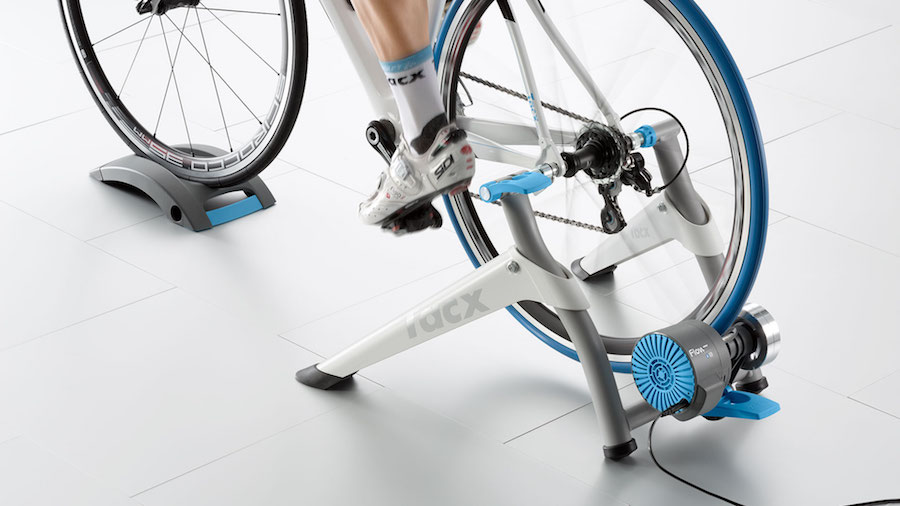By Eric Smith
Shares of Garmin Ltd. jumped $12.09, or 17 percent, to $83.06 at market close Wednesday after the company earlier in the day reported fourth-quarter earnings well above Wall Street’s targets, driven in part by 25 percent growth in outdoor.
But during the earnings call with analysts, it was Garmin’s recent acquisition of Tacx that caused the most excitement.
Garmin on February 12 signed an agreement to acquire Tacx Onroerend en Roerend Goed B.V (Tacx), a privately held Dutch company that designs and manufactures indoor bike trainers, tools and accessories, as well as indoor training software and applications.
The addition could be a game changer for Garmin as it enters one of the hottest fitness segments around thanks to the rise of Peloton, Wahoo and Zwift, among others.
In the press release issued last week, Garmin called the purchase—which is expected to close in the second quarter—“an exciting opportunity to expand into the year-round indoor cycling and training market.”
“We’ve built a very solid cycling business based on outdoor cycling activities and so Tacx allows us to bring cycling indoors and allows us to integrate across our platforms, both in terms of head units as well as Garmin Connect,” Cliff Pemble, president and CEO of Garmin, said on the earnings call. “So we see a lot of opportunities and synergies that we can work together with Tacx in order to better serve the overall cycling market.”
Read more: Garmin Agrees To Acquire Tacx
The company is extremely bullish on this latest addition to its portfolio. Garmin now anticipates revenue growth in 2019 of approximately 13 percent, which includes the acquisition of Tacx, as well as organic growth within the segment.
Pemble said Garmin had been “working to build relationships across the industry” when it approached Tacx, which he called an “awesome company” that not only has been family-owned for generations but “has a great product line and technology.”
Tacx is vertically integrated with in-house R&D and production. Headquartered in Wassenaar, Netherlands, with a distribution center in Vogt, Germany, the company employs nearly 200 associates, who will become part of the global Garmin team. Garmin said it is keeping the Tacx name to leverage current brand equity in the increasingly competitive and rapidly growing indoor training market.
“In terms of how we view them going forward, they have a great brand and it’s a brand that we want to support and keep around for the long-term and we intend to integrate them into our sales and our fitness area … to have a strong offering for both indoor and outdoor cycling activities,” Pemble said.
Tacx is currently undergoing a capital investment project to expand its R&D and production capacity, and now Garmin will look to take the company to new regions, channels and end-markets.
“We would anticipate the distribution would be through existing sports retailers,” Pemble said. “Already the product is available through REI, but there is an opportunity to expand Tacx distribution in the U.S. and Asia markets. They are very strong in Europe, but less strong in the U.S. and Asia. So we’ll be working to expand that distribution.”
And though Pemble wouldn’t comment on specifics, he did hint at Garmin offering online or video classes to accompany the Tacx product line—similar to what Peloton does.
“[T]here are many different assets within Garmin and Tacx that we can now look at together and create a much more high-fidelity and interesting experience for customers that go both outside and inside,” Pemble said. “So that’s our goal and we have a lot of work ahead of us for sure.”
The Tacx acquisition wasn’t the only reason for Garmin to celebrate Wednesday. For the fourth quarter ended December 29, 2018, Garmin reported revenue of $932 million, a 4 percent increase, with aviation, marine, outdoor and fitness collectively increasing 13 percent over the prior-year quarter. Total revenue beat estimates by $40.7 million. GAAP earnings per share was $1 and pro forma EPS was $1.02 for the quarter, ahead of expectations by 22 cents and representing growth of 26 percent over the prior year.
For 2018, Garmin reported total revenue of $3.3 billion, a 7 percent increase, with aviation, marine, outdoor and fitness collectively increasing 16 percent over the prior year. GAAP EPS was $3.66 and pro forma EPS was $3.69, representing 22 percent growth over the prior year.
Read more: Garmin Q4 Earnings Top Wall Street’s Targets
“2018 was another remarkable year of revenue and operating income growth driven by strong performance in our aviation, marine, outdoor and fitness segments,” Pemble said. “Entering 2019, we see many opportunities ahead and believe that we are well positioned to seize these opportunities with a strong lineup of products across all of our segments.”
The company’s outdoor segment has been especially impressive and has seen the most growth relative to other divisions in term of both revenue and operating income as a percentage of the company total.
In 2017, the most recent year available, the segment represented 23 percent of total company revenue—second only to fitness at 25 percent—up from 18 percent in 2016 and 15 percent in 2015. And the segment’s operating income for 2017 was 37 percent of company total—highest of all segments—up from 30 percent in 2016 (the year it overtook fitness in this metric) and 25 percent in 2015.
In the fourth quarter of 2018, outdoor segment revenue grew 25 percent behind significant contributions from adventure watches. Gross and operating margins improved to 67 percent and 38 percent, respectively, resulting in 31 percent operating income growth. During the quarter, Garmin launched Instinct, its newest line of adventure watch, and the GPSMAP 66 series of outdoor handhelds.
Pemble cited “strong demand for outdoor adventure watches, golf products and inReach subscription services” for the growth. The company anticipates revenue in the outdoor segment will increase approximately 10 percent in 2019, driven primarily by growth in watches and inReach subscriptions.
Meanwhile, revenue from the aviation segment grew 22 percent in the quarter with contributions from both the aftermarket and OEM categories. Gross and operating margins were 73 percent and 33 percent, respectively, resulting in 27 percent operating income growth.
But revenue from the fitness segment was flat in the quarter compared to a strong prior year quarter. Gross and operating margins increased to 52 percent and 21 percent, resulting in 2 percent operating income growth. Garmin recently introduced the Vivoactive 3 Music with 4G LTE, bringing connected safety features to the wrist.
Garmin said it currently expects 2019 revenue of approximately $3.5 billion as growth in fitness, aviation, outdoor and marine is partially offset by declines in the auto segment. The company currently expects its full-year EPS will be approximately $3.70 based upon improved gross margin of approximately 59.5 percent, operating margin of approximately 22.7 percent and a full-year effective tax rate of approximately 16.5 percent.
Photo courtesy Tacx
[author] [author_image timthumb=’on’]https://s.gravatar.com/avatar/dec6c8d990a5a173d9ae43e334e44145?s=80[/author_image] [author_info]Eric Smith is Senior Business Editor at SGB Media. Reach him at eric@sgbonline.com or 303-578-7008. Follow on Twitter or connect on LinkedIn.[/author_info] [/author]
















